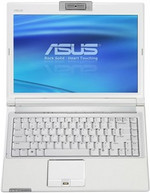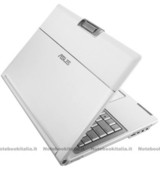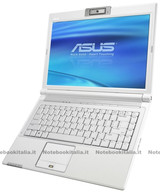Asus F8P
Specifications

Pricecompare
Average of 1 scores (from 2 reviews)
Reviews for the Asus F8P
Source: Notebookreview.com
 Archive.org version
Archive.org versionThere's little debate that for the average user, the Asus F8P is a respectably powerful device. Even for users requiring higher-than-average computing power, it holds its own. What's more ambiguous are the F8P's styling choices: the machine's looks are definitely love-it-or-hate-it. To my eye at least, the all black version has a more refined, less outlandish feel, with its more muted appearance potentially having broader appeal. Stylistic considerations aside, the F8P strikes a good balance between performance and portability, providing enough of both to make this a viable single-computer solution for many users. Battery life could be better and high screen gloss is an irritation, but beyond these issues the F8P is a polished, solid total package. Ultimately, if you're comfortable with the way it looks, the F8P is a computer that proves to be comfortable for the way most of us use our notebooks.
Verarbeitung zufriedenstellend, Display mäßig
User Review, online available, Medium, Date: 03/01/2008
Rating: display: 60% workmanship: 70%
Foreign Reviews
Source: Com! - 8/08

Comparison, , Medium, Date: 07/01/2008
Rating: Total score: 86% price: 90% performance: 100% features: 100% mobility: 68% ergonomy: 76%
Comment
ATI Mobility Radeon HD 2400: This DirectX 10 graphic card from ATI is the direct competitor to the NVIDIA GeForce 8400M GS graphic card for laptops. It features the Avivo HD video engine. The performance is not enaough for DX 10 games and high settings.
Only some 3D games with very low demands are playable with these cards.
» Further information can be found in our Comparison of Mobile Graphics Cards and the corresponding Benchmark List.
Intel Core 2 Duo: This is the Core Duo and Core Solo successor with a longer pipeline and 5-20% more speed without more power consumption. As an addition to the Core Duo design there exists a fourth decoder, an amplified SSE-unit and an additional arithmetical logical unit (ALU).
The Core 2 Duo for laptops is identical to the desktop Core 2 Duo processors but the notebook-processors work with lower voltages (0.95 to 1188 Volt) and a lower Frontside bus clock (1066 vs 667 MHz). The performance of equally clocked notebooks is 20-25% lower than Desktop PCs because of the lower Frontside bus clock and the slower hard disks.
T7500:
The Core 2 Duo T7500 is a Merom based Core 2 Duo with 4MB Level 2 Cache. It is positioned in the middle class (in 2009) and performs on par with a modern P7550 or Turion II Ultra M640/M660.
» Further information can be found in our Comparison of Mobile Processsors.14.10":
14 inch display size represents a middle ground between the small subnotebook formats and the screens of the standard 15 inch laptops.
The reason for the popularity of mid-sized displays is that this size is reasonably easy on the eyes, provides good resolutions with usable detail sizes, yet does not consume too much power and the devices can still be reasonably compact.
In the past, 14-inch devices were very rare, but now they are the standard for laptops after the 15-inchers.
» To find out how fine a display is, see our DPI List.Asus: ASUSTeK Computer Inc. is a major Taiwanese computer hardware manufacturer based in Taipei, founded in 1989. Under the Asus brand name, the company manufactures a wide range of products, including laptops, desktops, motherboards, graphics cards, monitors, smartphones and networking equipment, complete systems and PC components for end users.
Under the ROG (Republic of Gamers) brand name, ASUS manufactures gaming laptops known by gamers for their powerful specifications, dedicated graphics cards, high refresh rate displays and advanced cooling systems.
Beyond gaming, a wide range of notebooks are offered for different needs and budgets, from ultra-slim and lightweight ultrabooks to versatile 2-in-1 convertibles and budget-friendly options. In 2023, Asus had a 7% global market share of the PC market.
Customer satisfaction with ASUS notebooks concerns performance, the features, and the good price-performance ratio of ASUS notebooks. However, as with any brand, there are occasional reports of problems such as overheating, driver compatibility, or build quality issues.
86%: This is an above-average rating. Nevertheless, it should not be forgotten that about one fifth of all tested models receive a better rating.
» Further information can be found in our Notebook Purchase Guide.


 Deutsch
Deutsch English
English Español
Español Français
Français Italiano
Italiano Nederlands
Nederlands Polski
Polski Português
Português Русский
Русский Türkçe
Türkçe Svenska
Svenska Chinese
Chinese Magyar
Magyar

